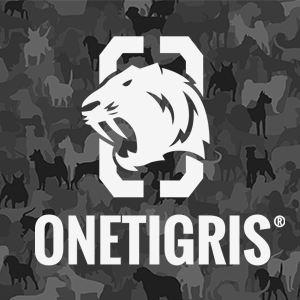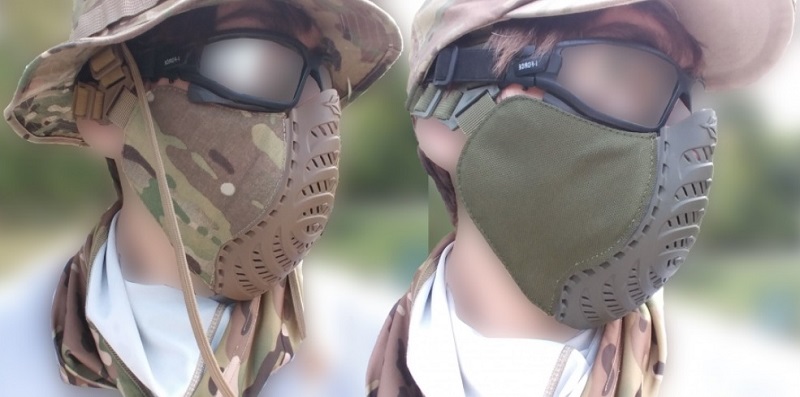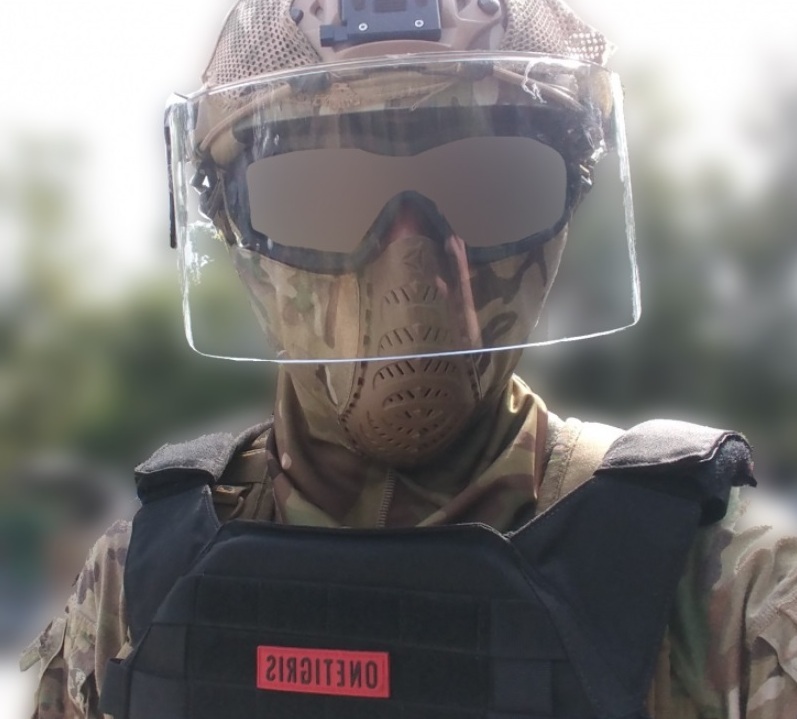

Quality 5/5
Appearance 4/5 (The appearance isn't for everyone, but it has its own distinct look.)
Function 4/5 (Absolutely solid design, but may not suit you in all use cases.)
Price 5/5 (It's a lightweight, TPU 500D/1000D Cordura hybrid. I think the price is good.)
Overall a worthy competitor and healthy entry in the OneTigris lineup.
I will primarily be using a T'farge from now on.
***
Before I start, here's some history on the T'Farge and its significance. The original T'Farge was a pioneer in hybrid masks several years ago. Prior to T'Farge, solid steel mesh was the standard. Players would often bend, warp, cut & pry at their mask to get a good fit, almost as a rite of passage. A common modification (often by players who really needed a good cheek weld, as to use variable and high powered optics) was to remove the lining on the top of the steel mesh mask, mark the contours of their goggles, cut out the steel mesh in the way, zip tie or otherwise secure the mask to the goggles, then hot glue the lining back on. This was problematic for a number of reasons:
Any bump, scrape, or movement to the mask would move your goggles. This is a safety issue many don't even realize. In Airsoft, due to the spherical shape and even the Magnus of the projectiles (as applied via the Hopup unit), BBs have a tendency to roll along or up the contours of whatever soft surface they hit. Hence in many places in the UK goggles must seal against the skin via hard gasket to protect against dangerous ricochets. Several other products came about around the same time and within the next few years, notably a simplistic Russian design which involved an aggressive bend of the steel mesh and some Cordura-like fabric replacing what would protect your cheekbones. There was also the B2Tac which has since disappeared and several other products involving balaclavas and steel mesh inserts.
Several influenced products (including the well known and beloved "OneTigris SCREAM mask" which substitutes thick Cordura and padding to protect the cheekbones, in place of steel, using carefully contoured - but universal - steel mesh where rigidity and rock-solid protection is required (nose and mouth). Safety priorities are different by person and culture. When players look for masks, here are some of the criteria: Coverage, comfort, looks, special use.
Some players prefer more coverage at the expense of comfort and appearance, while some aren't willing to give up their comfort or appearance.
What does the T'Farge design have over other designs?
Look
The design and appearance of the T'Farge definitely stands out as an aggressive, comfortable looking mask. Contrast this with other, steel-front counterparts. With the OneTigris SCREAM mesh mask, some users complain that through shape and shadowing, it can make their face look "monkey like". Sometimes users will hide the mask with a covering or wrap, doing so also helps to keep the mask in place but this can make fogging a real issue.
Here's an older setup I've ran with the OneTigris SCREAM mask and some lower profile goggles. (Pyramex I-Force and its Vulkan Zulu equivalent. I would be very curious to see how well Oakley M Frames with the Helo gasket kit work with these masks in general, but they are a little out of my price range right now.) While it looks excellent, covering up the mask introduces fogging issues.
Fit
The mask was designed to mesh well with lower profile goggles since the majority of players in the country of design (UK) use low profile goggles. What is curious here, is how aggressive the contouring around the nose is. This mask allows you aim down sights better than steel cordura hybrids, and for extra tricky motions, the mask will bend and flex as needed. The harness is pretty standard for hybrid mask products, OneTigris choosing the good angles that help the mask fit well in the majority of cases. The Earcup version fits very well, all things considered. Typically they look a little more elongated and fit slightly looser, but with adjustments, you can have it fitting and looking pretty good.
Protection
The T'Farge provides enhanced protection for the chin and nose, having a contoured defilade along the bridge of the nose to protect against frontal and angled projectiles. This is extra appealing because not every player has a perfect seal with their goggles whether that be the fit of equipment or the construction of the nose (or even broken noses!), and the extra protection reduces the risk of damage to the nose and nose bridge, as well as reducing the chance a BB will enter the goggles through a weak seal. Unfortunately, when it comes to larger goggles like the Desert Locust and Vulkan Sierra, most goggles don't mesh very well and not only leave part of the bridge of the nose exposed, but also push on the goggles, weakening or breaking the seal enough for a BB to easily enter if struck at the right place. Depending on your goggles, both low profile and higher profile, the aggressive contour on the nose bridge might clear better or worse than other masks. The OneTigris SCREAM mesh mask, might be another option since it has a shallower but larger cup to protect the nose bridge, and you can also warp and bend it slightly if needed. Overall, the fit really comes down to what your facial features, helmet, and goggles are.
Special Use
Being able to quickly don and doff your mask is important to users who play for long periods of time and occasionally need to eat or drink (especially drink) without touching their goggles or headgear. The helmet clips will provide the best and most consistent option when it comes to this. Being TPU in front of your nose and mouth, I noticed my breathing was a little louder than with a steel mesh front.
Why use the T’FARGE COMFORT design?
Extended protection from projectiles, comfort, ease of use without a helmet, ease of use with a helmet, and its distinct look.
For me, prior to this gear test, I've been using either the OneTigris Balaclava with integrated steel mesh or the OneTigris SCREAM mesh mask. I have an odd usage cause, since I'm using equipment that makes it hard for me to don and doff a mask quickly. I still need a fair amount of protection from projectiles, so normally I'll use a OneTigris Balaclava with integrated steel mesh because I can pull it out of the way to get to my water and then adjust it back into place right after. I don't need ear protection because my helmet protects my ears all the way. That being said, sometimes I need more protection; this is where the T'Farge comes in. It has its own distinct look, comfort, and simplicity.
My helmet doesn't accept helmet clips, but I've ran hybrid style masks underneath the helmet before. In the future, I plan on modifying my helmet to accept helmet clips so I can have the best of both worlds: The extended, stylish protection of the T'Farge, and the quick food and water access of the helmet clips.
Design feedback
The construction and stitch work as always, is really good. I really like how you can fold it away and not worry about falling or sitting on it and getting hurt like you would with a steel hybrid mask. I have one of the early T'Farge anti fog masks designed for females and people with smaller faces. It appears that between the two, the new design was simplified and optimized. The old mask utilized hidden stitches along the top seam, mating the cushioning material to the Cordura. What I liked about the early mask is the rubber gasket provides a more consistent fit, provided your helmet and goggles didn't interfere. It worked great with hats. The wearer of the anti fog mask with inner gasket never had an issue with fogging while wearing low profile goggles, which is surprising - although I've personally moved to larger goggles with an Exfog fan. However, the sample size for this is only a single game in 47 degree (F) 8(C) weather.
The anti fog mask with inner gasket, provides less protection for the jaw bone among other things. It's also a lot stiffer, which is a mixed blessing. The anti fog mask also sits slightly further off the face due to the inner gasket. The improved design can move and bend a little if needed, whereas the old one could not. I'd be curious to experiment with an improved version of the early lady anti fog mask. However, the early mask had a lot of extra padding. I haven't had hits to either mask along the sides, so I don't know if there's a noticeable difference in welting between the two. I know a common trait of early OneTigris masks (including the SCREAM) are while being very comfortable, sometimes because of the thick padding, they get hot. This probably belongs in a whole new conversation, but what if masks attached directly to the chinstrap and harness components or even used tensioners along the arc rails? Overall, I'm very glad to see the UK exclusive hitting the global market. It has a distinct look, and a distinct feature set.
The Multicam version (500D) feels slightly lighter and more pliable, even though on a scale, the weight between the 1000D and 500D masks are very close. I tried to compensate for discrepancies in the harness, so this may be in correct, but the weight difference between the Multicam version with QD buckle and standard harness (2.1Oz, 59.5G) and OD version with standard harness (2.3Oz, 65.2G) isn't that much. I think the Multicam version may hold less heat and breathe slightly better, but both are very good options. It's nice to have the option to go lighter and maybe a little cooler but also go a little heavier if needed.
I did an impact test on the TPU from near point blank and it barely left a scratch from over 10 0.28G bbs. As for the Cordura, I actually placed each mask version on my thigh and shot it with my G&G Raider 2.0 from about an inch away. It feels like a sharp, angry flick. Light redness around the site with no welting. Both were pretty comparable. You can see very slight discoloration on the Cordura where the BBs impacted. I will be curious to see if the 1000D version becomes more pliable as it wears.

As for the Earcup versions, I believe it's harder to pair with large goggles. It works best with lower profile goggles. Really, both designs work best with lower profile goggles, since the fabric and goggle frames often fight for position on your face. If you are using the helmet clip harness with the standard versions, this becomes less of an issue, since the mask has two stable points of suspension with the helmet that prevent the two from fighting. The downside, it's easier to move the mask vertically out of place, exposing your chin. It's not a big issue, since it stays in place very well the majority of the time. This is my preferred way to secure the mask.

What Still Needs Testing: The lifespan of the elastic harness.
US Safety Gear Requirements
Requirements in the US vary from field to field, most of them allow 18+ to wear only goggles, while younger have to wear lower masks or cloth over the face as well. younger are required to wear paintball masks. Some people prefer to go without a lower mask, but you are responsible for your own decisions.
The requirements on goggles are pretty simple, ANSI z871.1+ (+ sign meaning high impact designation) or greater, and are designed to seal themselves against the face around the eyes (via foam, rubber, etc) and have retention to keep them on the face. A few places will check to see if there is a gap (one pencil's width) or larger between your goggles and face, but most places do not. It is typically up to the wearer to make sure their stuff will take care of them. Some people prefer larger goggles that have an even higher rating. My local field allows up to 1.55 Joules for riflemen, and 3.6 Joules for a bolt action, along with a minimum distance for certain classes of replicas.
Here is a quote from "Milsim West's" requirements:
"Eye protection needs to meet ANSI Z87.1-1989 standards and must fully cover your eye sockets from all angles of impact. MSW will inspect all eyepro at check-in for adherence to this standard. If your eyepro is “on the border” of this standard then we will err on the side of caution and disapprove them. Ensure you have a backup that you know will 100% pass inspection. Steel mesh lenses are permitted. While not required, a mesh or other type lower face mask, a balaclava, bandana or mouth guard is suggested for protecting against dental injuries."
Steel mesh lenses are occasionally used, but you can get shrapnel from bbs in your eyes. Some places don't allow them.
Credit: @SturmFalke101, 1TG

